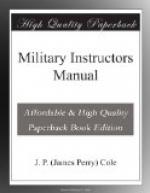Voice Culture.
Mastery of the voice is a necessity for every officer; for without it the giving of commands will soon make his throat look and feel like a piece of raw Hamburg steak. Quality of voice is more effective than quantity. Brute force may produce a roar that has tremendous volume at a short distance; but the sound will not carry unless it is so placed that it gets the benefit of the resonance spaces in the head. If the tone is produced properly, so that it has the singing quality necessary in all right commands, quantity of tone will come of itself.
This singing quality has nothing to do with music; it may be attained by a man who can hardly distinguish a bar of music from a bar of soap. It depends upon three principles, which are very simple in themselves but can not be applied without careful practise. The first covers proper use of the breath. Air must be drawn into the lungs by expanding the diaphragm and abdomen, a process best seen in the natural breathing of a man who is lying on his back with all muscles relaxed. Filling the upper part of the lungs by raising the chest puts the work on the comparatively small muscles between the ribs; but filling the base of the lungs by pulling downward brings into play the diaphragm, the largest muscle in the body. The sensation which accompanies proper deep control of the breath is as if the tone were not pushed out of the mouth, but drawn in and upwards. It is partly described by the phrases of singing teachers, “drawn tone” and “singing on the breath.”
The diaphragm must not only relieve the muscles between the ribs, but, still more important, the small muscles of the throat. The second great principle of voice production is that the throat must be perfectly relaxed. Any tension there interferes with the free vibration which is essential for strong and resonant tone. This relaxation is most easily gained by drawing the chin in slightly, loosening the muscles under it. The base of the tongue can be relaxed by rolling the letter “R,” even to the extent of making two syllables of such words as “gr-rand.” Talking with the teeth closed loosely will also help to ease incorrect, tension about the throat. If the throat is properly relaxed, there will be no sensation in it during the production of the voice. Any sensation between the diaphragm and the resonance chambers of the head is a sign of wrong and harmful tension.
The use of these resonance chambers is required by the third principle—that the tone must be reinforced by resonance in all the hollow spaces of the head. These are found in the nose, above the palate and even above the eyes. They have the same effect as the sounding board of a musical instrument, in giving quality to the tone. The best way to put this principle into practice is to learn the sensation of the clear and ringing tone which is produced by proper placing of the voice. Exercises containing the letters “M” and “N” will give this effect. This does not mean that the sound should be nasal; it should be made in the nose, but not through it. Another way to increase resonance is to think of crying the words rather than talking them. A slightly whining intonation or a sound like that of a laugh has more ring to it than an ordinary flat talking tone.




